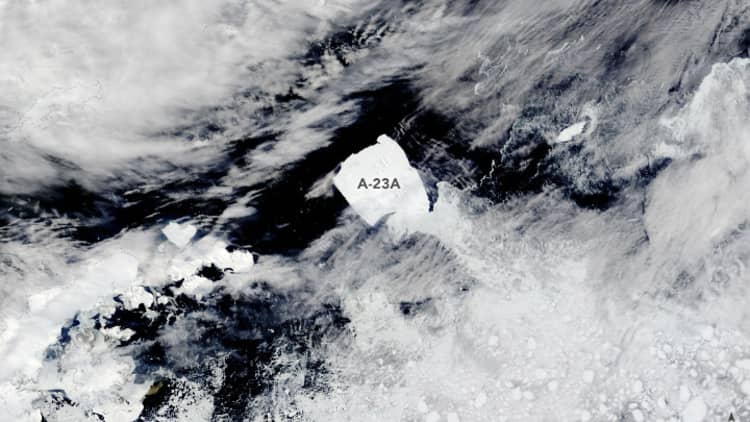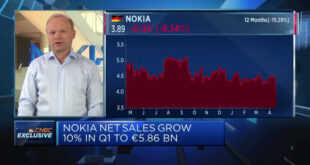
DUBAI, United Arab Emirates — Thousands of miles from the U.N.’s climate summit in the Middle East, the world’s largest iceberg is on the move for the first time in more than 35 years.
Scientists believe the juggernaut’s breakaway from Antarctica was a natural occurrence, but say it provides a stark reminder of the potentially disastrous implications as global sea levels rise.
The iceberg, known as A23a, is estimated to cover an expanse of almost 4,000 square kilometers (1,500 square miles), making it roughly three times the size of New York City.
Satellites have been closely tracking the iceberg’s movements from space after it recently broke free from the White Continent for the first time since 1986.
Robbie Mallett, a sea ice scientist and honorary research fellow at the University of College London, says there are a few reasons why A23a has captured people’s imagination.
“One is that this iceberg is absolutely massive,” Mallett told CNBC at the COP28 climate conference in the United Arab Emirates.
“It is the world’s biggest iceberg currently; it took that title back recently. And it is kind of a metaphor for how massive the cryosphere is, how big Antarctica is,” he continued. “It’s just astonishingly big and it’s a reminder of how much risk we’re at from sea level rise.”
Map shows path of Iceberg A23a as it breaks away from Antarctica.
NASA
The iceberg, which reportedly weighs nearly one trillion metric tons, has been seen freely drifting beyond Antarctic waters toward the Southern Ocean. It is expected to be swept to an area known as “iceberg alley,” putting it on a common iceberg trajectory toward the mountainous island of South Georgia.
The breakaway of A23a is thought to have been part of a natural “carving” process, but Mallet said icebergs are breaking off ice shelves at an increasing rate due to the climate crisis.
“Antarctica has historically been quite a small contributor to sea level rise, but it is growing, and it is taking up a bigger and bigger share of the sea level rise that we see every year,” he added. “So, it’s a symbol of the growing dominance of Antarctica in the sea level rise equation.”
‘Risk category number one’
On the first day of the U.N.’s annual climate conference last week, the World Meteorological Organization warned that a “deafening cacophony” of climate-fueled records was putting humanity at risk of losing the race to rein in sea level rise.
Its findings came shortly after a separate report said that if countries don’t quickly plan for steep emission cuts, global temperatures could rise by as much as 2.5 to 2.9 degrees Celsius (4.5 to 5.2 degrees Fahrenheit).
That’s almost twice the 1.5-degree level that the U.N. says is considered the “upper limit” to avoid the worst of what the climate crisis has in store.
The Arctic and the Antarctic seem very far away [from COP28], so if this huge iceberg can do one thing, it is to remind us that there are big systems out there and our future is intrinsically linked to that.
Gail Whiteman
Professor of sustainability at the University of Exeter
“It has been clearly shown that Antarctic glacier melting has been speeding up and that is one of tipping points we have to follow,” Petteri Taalas, secretary-general of the WMO, told CNBC in Dubai.
“For me, my risk category number one is how quickly the Antarctic glacier melts,” Taalas said.
At COP28, policymakers from nearly 200 countries are seeking to reach an agreement that can keep global warming to 1.5 degrees Celsius. This temperature threshold is widely recognized as crucial because so-called tipping points become more likely beyond this level.
Tipping points are thresholds at which small changes can lead to dramatic shifts in Earth’s entire life support system.
An event banner outside the Al Wasl dome in the Green Zone ahead of the COP28 climate conference at Expo City in Dubai, United Arab Emirates, on Tuesday, Nov. 28, 2023. More than 70,000 politicians, diplomats, campaigners, financiers and business leaders will fly to Dubai to talk about arresting the world’s slide toward environmental catastrophe. Photographer: Hollie Adams/Bloomberg via Getty Images
Bloomberg | Bloomberg | Getty Images
A major study published in the journal Science last year identified 16 tipping points, with several identified in the polar regions. The study’s authors cited West Antarctic ice sheet collapse as one of the tipping points that could be triggered if global warming reaches 1.5 degrees Celsius.
The world has already warmed by around 1.1 degrees Celsius, scientists say, after over a century of burning fossil fuels as well as unequal and unsustainable energy and land use.
‘The poles will determine the state of humanity’
Gail Whiteman, professor of sustainability at the University of Exeter, told CNBC at COP28 that the world’s largest iceberg breaking off from Antarctica serves as “a physical reminder that what happens in the poles doesn’t stay there.”
“Now, everybody is worried about this huge iceberg and where is it going to go … it’s game on, so to speak,” she added.
“The Antarctic used to be seen as this sleeping giant, nothing was happening. It was just big and really cold — that’s my non-scientific way of saying it. And now it’s clear based on the sea ice that it is actually destabilizing.”
On November 27, 2023, a break in the swirling cloud cover allowed a glimpse of the Earth’s largest iceberg drifting past the tip of the Antarctic Peninsula.
Courtesy: NASA Modis
“The poles will determine the fate of humanity. The discussion here should be about the polar regions because they are tipping first — and once they do, the issue of adaptation becomes that much more critical,” Whiteman said.
“The Arctic and the Antarctic seem very far away [from COP28], so if this huge iceberg can do one thing, it is to remind us that there are big systems out there and our future is intrinsically linked to that,” she added.
 EU News Digest Latest News & Updates
EU News Digest Latest News & Updates


